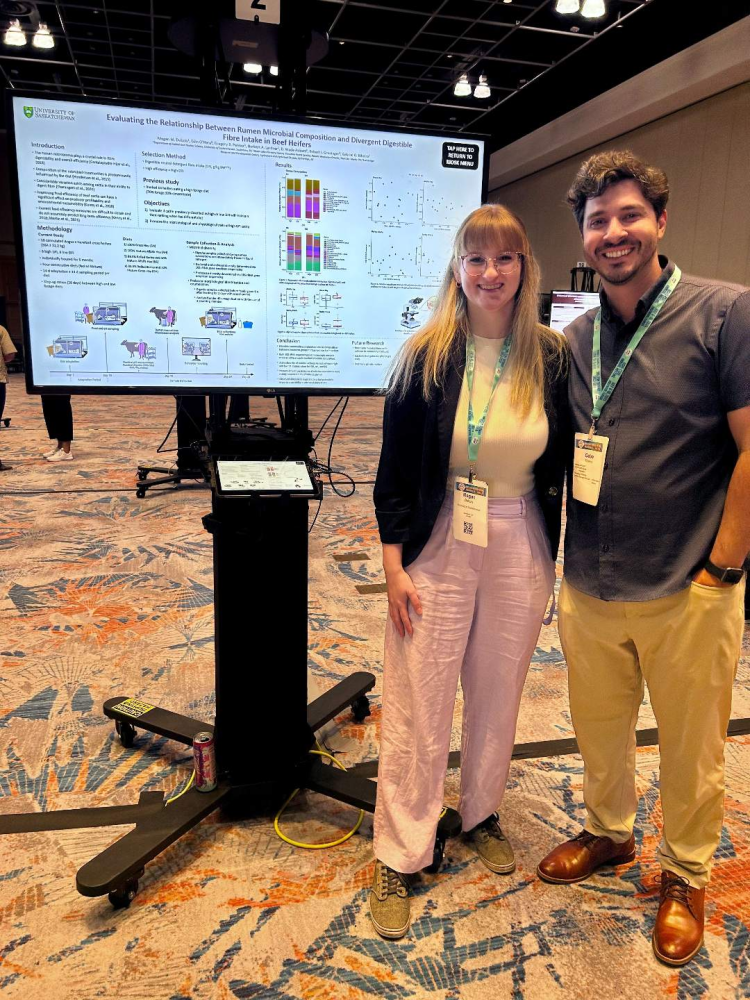As USask spotlights Saskatchewan Agriculture Week in October, we profile researchers uncovering surprising findings from comparing heifers' digestion behaviours.

Dr. Gabriel Ribeiro (PhD) and master's student Megan Dubois presenting a poster from the study at the 2025 American Society of Animal Science - Canadian Society of Animal Science Annual Meeting in Hollywood, Florida. (Photo: Submitted)
It's a classic scene on any prairie vista: the placid cow moving its great jaw, chewing forage for what seems forever.
Most denizens of the Prairies grasp that this chewing, known as rumination, is an important part of complex bovine digestion. But what even scientists have not understood is how important.
Dr. Gabriel Ribeiro (PhD), associate professor in the University of Saskatchewan's (USask) College of Agriculture and Bioresources (AgBio) and Saskatchewan Beef Industry Chair, set out to investigate what seems to be a relatively simple question why do some cows digest fibre better than others in a four-part study conducted with master's candidate Megan Dubois.
The results were far from simple. Indeed, they proved not just interesting but somewhat surprising.
Ribeiro and Dubois learned that cattle with higher digestible-fibre intake had better feed efficiency an animal's ability to convert feed into body weight gain.
Ribeiro had seen a huge variability among animals in his previous research, and this most recent study was intended to advance understanding of the animals' physiology and rumen (first stomach of a cow that receives food or cud) microbiology, to see if there were, for example, specific ruminal microbes that would explain those differences.
But better feed efficiency was not the only parameter Ribeiro and Dubois were testing for.
"When we started this project, we didn't have any focus on methane or greenhouse gases," he said. "We were really focused on understanding why some animals digest fibre and do better on low-quality diets and high-forage diets than others."
As they moved forward with the project, they decided to also address rising concerns from society over how beef cattle affect the environment, to see whether greenhouse gas emissions notably methane could be reduced.
"Our previous thought was if these animals eat more fibre and digest it better, we expected that they would produce more methane," Ribeiro said.
However, when they measured methane, they did not see that. Rather, the total enteric methane produced per day was the same amount as the other group's, but when expressed per kilo of feed digested, they produced less methane.
"And if they gain more weight, that would mean less methane per kilo of beef," Ribeiro said.
"We were quite surprised at that."
Sixteen heifers
Ribeiro and Dubois began the study with 64 black Angus crossbred heifers, all from the same herd to reduce variation due to cattle source.
Then they selected the top eight (most efficient) which ate and digested fibre the best, along with the bottom eight (least efficient). The study was performed at the USask Livestock and Forage Centre of Excellence.
In her research, Dubois saw that the top heifers which ate more and digested fibre better, ate more quickly and gained weight faster.
"We have some ideas about why this is happening," Ribeiro said. "We did see some small changes in the rumen microbiome and did measure that in our previous work, but they are not large or drastic changes."
So, they also looked at the heifers' chewing behaviour. Indeed, the better-performing animals spent more time chewing (i.e. ruminating) that diet.
The researchers were also interested to see if these differences would hold up when the animals were fed diets with high amounts of grain content, which they did.
"That kind of helps explain why they digest fibre better because by ruminating it more, chewing more, it helps break down the fibre and helps microbes in the rumen digest that fibre," Ribeiro said.
"We also think because they eat more, there might be faster transit throughout the digestive tract, so there's less opportunity for microbes (i.e. methanogenic archaea) to produce methane."
He noted that producers are pressured to reduce methane production, but most available strategies are expensive and do not provide financial benefits to the farm or ranch.
"Whenever we propose new technologies, we have to make sure it solves a problem but doesn't just add costs to the producer," Ribeiro said.
The study was funded by the Natural Sciences and Engineering Research Council of Canada (NSERC), Beef Cattle Research Council (BCRC), Aberta Beef Producers (ABP), and Saskatchewan Cattle Association (SCA).
To be continued
The study was completed last year and now Dubois is writing the results paper. She will defend her master's thesis next month and start her PhD to follow up on the project by looking at larger numbers of animals and try to connect them with genetics.
"There are a lot of things that genetics drive that could be causing those different phenotypes to come out. I'm not quite sure what we're looking at, but there is something there. We just don't have the numbers yet," she said.
While few studies have been done that support their findings, Ribeiro said that a recent meta-analysis study (a study summarizing data from multiple research studies) from Europe found similar results.
"With that, we are planning to do a lot more work in this area, hopefully, if we get all the funding in place that we are working on now," Ribeiro said.
Funding from the Agriculture and Agri-Food Canada's Agriculture Methane Reduction Challenge and industry funds from the BCRC and the Alberta Results Driven Agriculture Research (RDAR) are already in place for this future work.
The next step will be to understand the better-performing heifer phenotype and look at it in a larger group.
"The main problem we have is to do that deep work, we need to get more phenotypes and those are very expensive to get," Ribeiro said.
Ribeiro plans to build a research team around this study. He has already received support from professors and researchers Dr. Bart Lardner (PhD) and Dr. Greg Penner (PhD), and Dr. Mika Asai-Coakwell (PhD) (geneticist), all in the AgBio college, and Dr. Robert Gruninger (PhD) (rumen microbiologist) from AAFC in Lethbridge, Alta. He also hopes to connect with the genetics team at the University of Alberta.
"We need a lot of brains together to think about what's going on, what it means," Ribeiro said. "And to think toward the future. What do we do next?
"By selecting those heifers that can eat and digest fibre more efficiently, we think there's an opportunity to reduce the cost of production and increase profitability. So, I think for the producer, that's super important."
Down the road, producers themselves could select for these positive traits, he said.
"We're trying to find an easy way to identify those animals and create the technology for producers to make it easy to identify this phenotype, perhaps by DNA testing a blood or hair sample."
For cattle producers, the research could ultimately be herd-changing. By selecting for hungrier heifers that eat faster and spend more time ruminating, you could produce heavier cattle at a much lower cost and with lower methane emissions.













